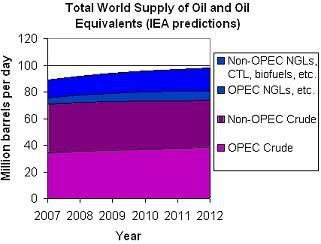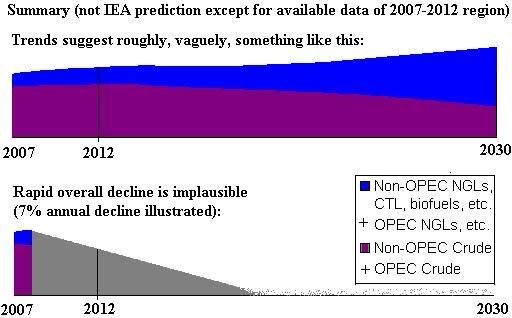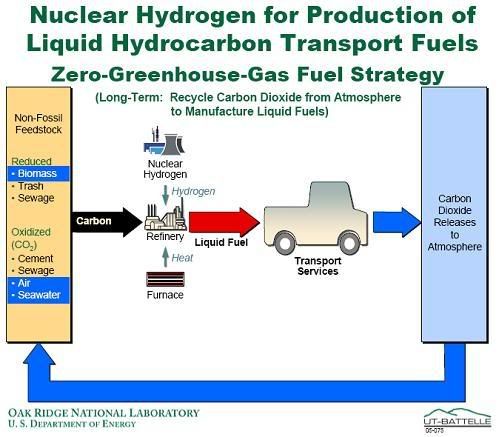Maybe a mod should split the thread if this continues much.
Replying to posts:
Stas Bush wrote:Sikon wrote:For example, almost all electricity production is already not oil fueled, as discussed in previous posts, and there is nothing making the price of electrical energy in 2025, 2050, 2100, or 2500 necessarily be much more expensive than today ... indeed, price decrease is quite within the realm of the possibility.
Why does electricity price rise in my home country which is one of the largest oil and gas extractors and exporters?
Almost zero generation is from oil,
only 2%, no doubt from specialty applications such as portable generators and
peaker plants, as other energy is cheaper even today. However, Russia's electricity is 46% from natural gas, rather susceptible to natural gas price increase, more so than most other nations which are primarily coal generation instead.
But electricity prices in France among the lowest in Europe illustrate the long-term potential for competitive electricity price after switching away from fossil fuels. And that's just with 20th-century designs.
One of the long-term weaknesses of fossil fuels, aside from limited supply and environmental problems, is that they have no great potential for cost improvement since most expense is unavoidably from the large quantities of fuel consumed. But next-generation nuclear power is projected to have improved economics even in the modern regulatory environment, let alone the potential of the more distant future like 22nd or 23rd century reactors. Though far more expensive than nuclear today for average generation, different from rated peak power, solar power has potential too, terrestrial or
SSPS. A technological trend is shown by $21 per watt rated peak power obtained in 1980, $2 to $3 today,
an estimated $0.90 to $1.50 anticipated in 2010, etc. Cheap electrical energy may indeed be a future possibility.
Stas Bush wrote:Sikon wrote:U.S. gasoline prices have been $2 to $3 per gallon recently, but Europeans have already handled paying ~ $5 to $7 per gallon (due to taxes but the equivalent effect to the consumer of that much production expense).
Are you saying gas station prices are not going to have a depressive effect on the U.S. transportation network?
No, naturally price increase is economically undesirable (albeit with indirect benefits for green tech advancement), although more than the
recent 3% of U.S. GDP being spent on gasoline is survivable.
aerius wrote:Sikon wrote:Expansion of supply can lag behind expansion of desired demand, resulting in price increase for a time. As previously shown, the recent situation has been the total production of oil plus oil-equivalents increasing but not as fast as the willingness of consumers in the global marketplace to bid higher with economic growth in countries such as China. Since production of substitutes for conventional crude oil is currently only about 20% of the total, its expansion rate of about 6% annually is not yet enough ... but such exponential growth does vastly change the picture in time.
Except for the last 2 months of 2007, there hasn't been in increase in oil & oil equivalents production since 2005. 2 months worth of data isn't enough to determine if the increase is a temporary blip, of which there have been several since 2005 or the beginning of a long-term trend.
Although data points of two years wouldn't be particularly important for judging trends over decades, that's not even accurate. Total production in 2006 was an increase over 2005 by about 1% (IEA,
table 1 and
past data); 2007 was very slightly more than 2006; and production in each year was more than the preceding year, back to the 1990s and beyond.
More to the point, the production of oil-equivalents has been increasing relatively quickly. The total supply of oil plus oil-equivalents has not had the same percentage rise, only a lesser relative rate, but that's currently mostly conventional crude after all, of which production in some areas has been declining.
Possibly in a future year the decline rate of some components of conventional crude production might exceed the increase rate of substitutes, for a net decrease in total production, although the IEA medium-term report doesn't predict that. But temporary trouble from time delay in expanding of production of substitutes wouldn't mean the permanent end of relatively affordable liquid fuel in the long term, let alone the end of cheap energy (like cheap electrical energy) in general.
IEA 5-year prediction, from data and references described
here:

In other threads, there have been claims of future rapid overall decline, e.g. 7%
decline per year and 8%/year
claims ... but trends are rather different:

Stas Bush wrote:Sikon wrote:As previously shown, the recent situation has been the total production of oil plus oil-equivalents increasing but not as fast as the willingness of consumers in the global marketplace to bid higher with economic growth in countries such as China.
Do oil equivalents have the same price as oil? Does their price increase or decrease? What is their energy efficiency? How scalable is their production?
Sikon wrote:Expanded production of synthetics helps conventional crude continue dropping from 80% of the total now to eventually 70%, 50%, 30%, someday ~ 0%.
What are the costs of production (a graph?) and what is the energy efficiency?
aerius wrote:The other problem is that oil equivalents such as natural gas liquids, tar sands, ethanol and so forth do not have the energy density of oil, and in the case of tar sands and ethanol the EROEI is far worse than that of conventional oil.
The above quotes are rearranged together, to respond to everybody at once on the similar topic.
Ethanol has a little lower energy density than gasoline, resulting in
around 30% less mileage per gallon (unless an engine is optimized for higher compression ratio to take advantage of ethanol's higher octane, in which case mileage is similar) ... but there's greater variation in vehicle miles per gallon efficiency than that moderate difference anyway.
Synthetic gasoline and diesel fuel from Fischer-Tropsch methods such as coal to liquids, NGL, and biomass gasification have about the same chemical composition and the same energy density as from conventional sources, e.g. the usual 120 MJ/gallon LHV energy density for gasoline. Such is mixed into the fuel stream today although the average consumer doesn't even know it, identical to their car's engine (aside from lower impurities).
Except for the limited influence of government support in some cases, all oil-equivalents in commercial production today must have roughly equivalent expense to the current price of oil --or better--, as else the companies would go bankrupt from selling at major loss.
The majority of current Fischer-Tropsch fuel synthesis is from natural gas (NGL), plus coal to liquids, but, as prices rise, biomass gasification becomes a competitive option (which can convert non-food biomass). Synthetic fuel from the FT process with syngas produced from biomass can cost
as little as around $20 to $27 per GJ (LHV), which corresponds to on the order of ~ $2.40 to $3.20/gallon. A decade ago, when regular gasoline was selling for not much more than $1 per gallon in the U.S., that would have been uncompetitive, but, as gasoline prices have reached $3/gallon, the situation is changing.
The current cost of production of cellulosic ethanol is
around $2.25 per gallon, like $3 per gallon of gasoline equivalent, with major
future cost reduction anticipated.
EROEI figures vary, such as
around 5:1 for oil sands, a low figure for corn ethanol but
around 7:1 for cellulosic ethanol, etc.
As long as EROEI isn't below 1 and isn't too close to 1, the system works. If, for example, one method has an EROEI of 5 while another has one of 10, the former is equivalent to recycling 20% instead of 10% of output energy, for about a tenth more trouble per unit of net output, if all else was equal. But plus or minus a few percent is of limited importance in the big picture of general future prediction. Besides, it is the end-user where there is far greater variation in efficiency than in the production process. Whether the amount of energy recycled for the production process is closer to 10%, 20%, or 30%, some vehicles are 200% or 300% as efficient as others in mileage.
Of course, though the equivalent of recycling energy output is mentioned for simplicity, the actual situation can be better. As an example, in the case in oil shale (EROEI
which is 3 to 7), the heat for the production process may
actually come from nuclear energy (or else coal or natural gas) rather than the liquid fuel output. That's not surprising, considering how liquid fuel is comparatively expensive energy even today, primarily used if but only if portable convenience is a greater goal than minimum cost per GJ ... the reason almost no U.S. electricity generation runs on oil since decades ago.
What's most important is not so much the earlier cost figures in themselves as their order of magnitude and what they are not. Production costs like several dollars per gallon are not even the $8/gallon (with taxes) in part of Europe today, let alone, say, the $30/gallon that it would take to make the fuel cost of a 30 mpg vehicle be $1 per mile. In some future year or decade, retail fuel prices might nevertheless temporarily rise much higher than the nominal production costs, considering the current tendency for plant production to have a time delay compared to rapidly expanding desired demand, but the production costs are relevant in the long term.
To put the matter simply, there might, maybe be the equivalent of $10 or $20 per gallon fuel prices someday (although that's not at all necessarily going to happen), but it wouldn't be a permanent situation if so.
Methods like cellulosic ethanol, thermal depolymerization, and biomass gasification have a large potential feedstock of biomass to work from, e.g. a U.S. DoE & USDA study
having estimated 370 million dry tons annually sustainably from forestlands (growth rate of new trees balancing usage), 430 million dry tons annually of crop residues (non-edible plant mass), etc. for a total of about 1 billion tons. That study included usage of 90 million tons of grain for biofuels, but 90+% of the biomass was non-food. The preceding is more of a lower limit than an upper limit. The study explicitly mentioned not considering the additional production which is possible in event of substantial change in land management.
In any case, at least a huge fraction, at least several tens of percent of current petroleum consumption can be replaced by liquid fuel production from biomass even without or before large change to land management. Since the real world doesn't consist of pursuing a single method to the exclusion of the rest, that's a substantial amount when combined with other fuel synthesis, increased substitution of electric transportation, etc. Renewable methods will continue to be supplemented by usage of other fossil fuels (coal to liquids, oil sands, etc) in the near-term future of the next few decades.
In the longer term, more major changes to land usage have the potential of allowing biofuel production up to as much or more than current petroleum consumption if desired. It has been
estimated that on the order of 15000 square miles of algae biofuel farms could produce as much liquid fuel as current U.S. petroleum usage. While there's some percent uncertainty in the particular figure, the important aspect is the order of magnitude. Such may superficially seem like a lot, but actually it is only around 0.4% as much as total U.S. land area (3.5 million square miles).
The ultimate in scalability would be synthetic fuel
production from captured CO2 with hydrogen generated by nuclear power plants, or by solar energy. That's a method not commercially implemented yet, but much of this discussion is about the long term future. Given enough CO2 availability, up to atmospheric capture, such could be scaled up to a practically unlimited degree, only limited by economics (no shortage of uranium) within the relevant range of plausible liquid fuel needs.
aerius wrote:Also with regards to oil equivalents, I'm rather doubtful whether the historical 6% per year growth rates can be maintained into the future. Can we really make 30-40 million barrels a day of oil substitutes in the next 30 years or so? We can do it in theory if the lab tests prove out, but can it actually be scaled up to full volume production, and can we actually get all the people trained and infrastructure built?
aerius wrote:There's nothing like that for oil substitutes, we have no clue on how much it can be ramped up in the future, and that's why I think there's no way you can extrapolate the 6% per year growth rate years or decades into the future.
"We" as in you is not the same as the IEA, DoE, or USDA...
There are studies like those mentioned previously, on biomass availability and other factors.
The USDA has a goal of obtaining
around as much as 15% of current U.S. gasoline consumption from cellulosic ethanol by 2017, superficially not a huge amount, but that kind of increase over one decade could add up a lot more over several decades, in combination with other sources (CTL, NGLs, oil sands, biomass gasification, etc., etc).
The primary international professional body, the IEA, estimates the total of
all substitutes for conventional crude oil to increase from ~ 18.5 million barrels per day in 2007 to ~ 24.5 million barrels per day in 2012. That doesn't necessarily mean it would continue at exactly a 6% annual increase rate to reach nominally more than 100 million barrels per day by 30 years from now, but it is headed for at least some substantial increase over 2007 production. And much is possible eventually:

The above illustration is from the U.S. Department of Energy, a presentation
here.
This is still talking about only a relatively small segment of the total economy and workforce, such as recent U.S. expenditures on motor gasoline being
about 3% of GDP. If several tens of percent as much per decade is reallocated, averaging several percent per year, the portion of GDP being reallocated can be on the order of 0.1% of GDP per year. That's approximate, but the general idea is this is not an unobtainable astronomical amount. The rate of change to the economy required to win WWII was much greater. Of course, this is not a matter of a simple decision from on high but a tendency for individual companies and governments to continue to work on expanding substitute production due to the financial incentive as conventional crude production becomes further behind desired demand growth.
Although adding a few new points, this is getting boring, as the preceding discussion is rather repetitive of past threads.
Beyond all this, whatever the details of the next few decades, even if there were large economic troubles temporarily, switch away from conventional crude is a future inevitability anyway. For example, conventional crude oil becoming expensive can't make the 22nd century have expensive energy since liquid fuel production will not be based on crude oil then, given how its supply will decline. That will be a better situation, in combination with more advanced electric transportation and the technology for relatively cheap electrical energy.
What's needed now is not to disparage the potential to switch away from conventional crude but to encourage such, since, while it will occur over time regardless, relatively fast progress would be best for environmental and economic reasons.







